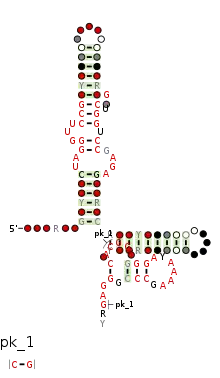| ykkC-yxkD leader | |
|---|---|
 Predicted secondary structure and sequence conservation of ykkC-yxkD | |
| Identifiers | |
| Symbol | ykkC-yxkD |
| Rfam | RF00442 |
| Other data | |
| RNA type | Cis-reg; riboswitch |
| Domain(s) | Bacteria |
| SO | SO:0000233 |
| PDB structures | PDBe |
The ykkC/yxkD leader is a conserved RNA structure found upstream of the ykkC and yxkD genes in Bacillus subtilis and related genes in other bacteria. The function of this family is unclear for many years although it has been suggested that it may function to switch on efflux pumps and detoxification systems in response to harmful environmental molecules.[1] The Thermoanaerobacter tengcongensis sequence AE013027 overlaps with that of purine riboswitch suggesting that the two riboswitches may work in conjunction to regulate the upstream gene which codes for TTE0584 (Q8RC62), a member of the permease family.
Nelson et al.[2] showed that this riboswitch senses and responds to guanidine and it was renamed Guanidine-I riboswitch. Furthermore, they demonstrated that bacteria are capable of endogenously producing guanidine and the riboswitch controls genes whose products are involved in modification or pumping out guanidine as a toxic compound from bacteria. Crystal structures of the riboswitch bound to the ligand have also been determined.[3][4]
The mini-ykkC RNA motif is a putative cis-regulatory element that apparently regulates similar genes to those regulated by the Guanidine-I riboswitch (ykkC/yxkD leader). However, the mini-ykkC RNA motif is simpler in structure and has fewer highly conserved nucleotide positions than the ykkC-yxkD leader.[5] Despite this each of its two stem-loop structures directly bind free guanidine. Therefore, mini-ykkC RNA motif represents a distinct class of guanidine-sensing RNAs called Guanidine-II riboswitch.[6] Its crystal structure was also determined.[7]
The ykkC-III RNA motif[8] is a distinct candidate cis-regulatory RNA that appears to regulate genes related to the preceding motifs. Although the structure of ykkC-III RNAs does not resemble ykkC/yxkD RNAs, both have a structure complexity that led to the proposal that they represent riboswitches. The ykkC-III motif has a rigidly conserved ACGA sequence within it that resembles a less rigidly conserved ACGA or ACGG sequence found in mini-ykkC RNAs, but it is unknown whether this observation relates to a biological relationship. Biochemical validation has been presented to show that this motif is a third class of guanidine riboswitches called Guanidine-III riboswitch.[9]

References
- ↑ Barrick, JE; Corbino KA; Winkler WC; Nahvi A; Mandal M; Collins J; Lee M; Roth A; Sudarsan N; Jona I; Wickiser JK; Breaker RR (2004). "New RNA motifs suggest an expanded scope for riboswitches in bacterial genetic control". Proc Natl Acad Sci USA. 101 (17): 6421–6426. Bibcode:2004PNAS..101.6421B. doi:10.1073/pnas.0308014101. PMC 404060. PMID 15096624.
- ↑ Nelson, James W.; Atilho, Ruben M.; Sherlock, Madeline E.; Stockbridge, Randy B.; Breaker, Ronald R. (2017-01-19). "Metabolism of Free Guanidine in Bacteria Is Regulated by a Widespread Riboswitch Class". Molecular Cell. 65 (2): 220–230. doi:10.1016/j.molcel.2016.11.019. ISSN 1097-4164. PMC 5360189. PMID 27989440.
- ↑ Battaglia, Robert A.; Price, Ian R.; Ke, Ailong (April 2017). "Structural basis for guanidine sensing by the ykkC family of riboswitches". RNA. 23 (4): 578–585. doi:10.1261/rna.060186.116. ISSN 1469-9001. PMC 5340920. PMID 28096518.
- ↑ Reiss, Caroline W.; Xiong, Yong; Strobel, Scott A. (2017-01-03). "Structural Basis for Ligand Binding to the Guanidine-I Riboswitch". Structure. 25 (1): 195–202. doi:10.1016/j.str.2016.11.020. ISSN 1878-4186. PMC 5317007. PMID 28017522.
- ↑ Weinberg Z, Barrick JE, Yao Z, et al. (2007). "Identification of 22 candidate structured RNAs in bacteria using the CMfinder comparative genomics pipeline". Nucleic Acids Res. 35 (14): 4809–4819. doi:10.1093/nar/gkm487. PMC 1950547. PMID 17621584.
- ↑ Sherlock, Madeline E.; Malkowski, Sarah N.; Breaker, Ronald R. (2017-01-17). "Biochemical Validation of a Second Guanidine Riboswitch Class in Bacteria". Biochemistry. 56 (2): 352–358. doi:10.1021/acs.biochem.6b01270. ISSN 1520-4995. PMC 5340285. PMID 28001368.
- ↑ Huang, Lin; Wang, Jia; Lilley, David M. J. (2017-06-22). "The Structure of the Guanidine-II Riboswitch". Cell Chemical Biology. 24 (6): 695–702.e2. doi:10.1016/j.chembiol.2017.05.014. ISSN 2451-9456. PMC 5486947. PMID 28529131.
- 1 2 Weinberg Z, Wang JX, Bogue J, et al. (March 2010). "Comparative genomics reveals 104 candidate structured RNAs from bacteria, archaea, and their metagenomes". Genome Biol. 11 (3): R31. doi:10.1186/gb-2010-11-3-r31. PMC 2864571. PMID 20230605.
- ↑ Sherlock, Madeline E.; Breaker, Ronald R. (2017-01-17). "Biochemical Validation of a Third Guanidine Riboswitch Class in Bacteria". Biochemistry. 56 (2): 359–363. doi:10.1021/acs.biochem.6b01271. ISSN 1520-4995. PMC 5315414. PMID 28001372.